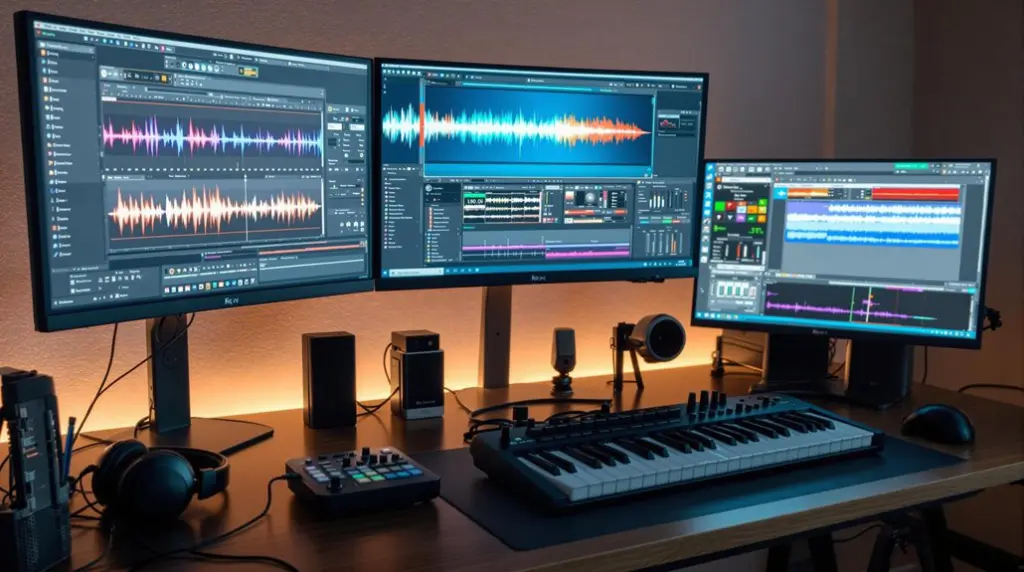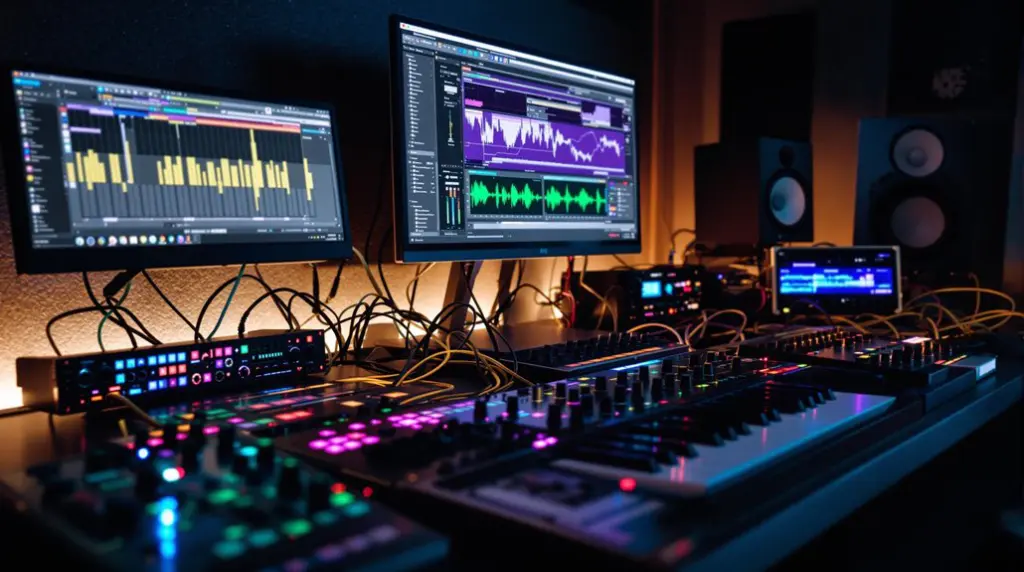The Moog Matriarch Synthesizer boasts five key features that set it apart. Its semi-modular architecture supports monophonic, duophonic, and polyphonic modes, providing extensive tonal versatility. Equipped with four Voltage Controlled Oscillators and dual 24dB/oct resonant filters, its sound design capabilities are rich and dynamic. The integration of two patchable ADSR envelopes and versatile LFOs enhances modulation options. Performance is enhanced by a 49-note Fatar semi-weighted keyboard with aftertouch and built-in sequencer and arpeggiator. Solid connectivity through MIDI, CV, and USB guarantees seamless integration into any setup. Discover more about how these features coalesce to redefine synth creativity.
Key Takeaways
- Semi-Modular Architecture: Provides versatile monophonic, duophonic, and polyphonic modes without extensive patching.
- Four VCOs: Offers rich tonal possibilities with triangle, sawtooth, narrow pulse, and square waveforms.
- Dual 24dB/oct Filters: Features Series, Parallel, and Stereo modes with intuitive Cutoff and Spacing controls.
- 49-Note Fatar Keyboard: Semi-weighted with aftertouch, enhancing expressive playability.
- Comprehensive Connectivity: Includes MIDI, CV inputs/outputs, audio input, and USB for seamless integration with other gear and software.
Overview and Design
Often regarded as a pinnacle of synthesizer craftsmanship, the Moog Matriarch stands out with its semi-modular design and four-note paraphonic architecture, which collectively provide an exceptional range of sound creation possibilities.
The semi-modular flexibility of the Matriarch allows users to experiment with monophonic, duophonic, and polyphonic modes without the need for extensive patching, making it both user-friendly and versatile.
The instrument’s 256-step sequencer and arpeggiator further enhance its creative potential, enabling intricate rhythmic variations and complex sequencing capabilities.
With 90 patch points, the Matriarch offers extensive modular connectivity, allowing seamless integration with other modular systems and devices, thereby expanding its sonic horizons.
Constructed with a robust metal chassis and featuring a high-quality Fatar keyboard, the Moog Matriarch emphasizes durability and a premium tactile experience.
The design exudes vintage aesthetics, reminiscent of classic Moog synthesizers, yet it incorporates modern functionalities to satisfy contemporary electronic musicians.
Priced at £1,959, the Matriarch successfully bridges the gap between nostalgic analog warmth and cutting-edge synthesis, appealing to both traditionalists and forward-thinking sound designers.
This combination of heritage and innovation guarantees the Moog Matriarch remains a formidable tool in any musician’s arsenal.
Oscillators and Filters
At the heart of the Moog Matriarch’s sonic prowess are its four identical Voltage Controlled Oscillators (VCOs), each offering a selection of waveforms—triangle, sawtooth, narrow pulse, and square—that enable diverse and intricate sound creation.
These oscillator types provide the foundation for the rich, analog textures synonymous with the Moog brand. Each VCO is equipped with fine-tuning controls and the ability to synchronize with the others, thereby enhancing the tonal richness and complexity achievable during sound design. The precise control over frequency issues using these oscillators is vital for achieving professional sound quality.
The Moog Matriarch’s dual 24dB/oct resonant filters, derived from the classic Moog 904A module, introduce a new level of versatility with their operational modes: Series, Parallel, and Stereo.
These filter modes enable users to experiment with various filtering techniques, from traditional subtractive synthesis to more experimental approaches. The single Cutoff knob and Spacing control offer intuitive manipulation of filter frequencies, allowing for unique sound shaping and modulation effects.
Additionally, the Matriarch’s mixer design facilitates seamless integration of audio signals and control voltages, promoting an intuitive workflow that invites creative exploration.
This combination of sophisticated oscillators and versatile filters underscores the Matriarch’s role as a powerful tool in any sound designer’s arsenal.
Modulation Capabilities
Releasing the Moog Matriarch‘s full potential lies in its robust modulation capabilities, which can transform simple tones into complex, evolving textures. Central to this are the two patchable Moog ADSR envelopes, which provide extensive envelope modulation options. These envelopes can influence various parameters beyond amplitude and filter, enabling intricate control over sound evolution.
By optimizing audio levels and carefully adjusting EQ settings, users can additionally enhance the clarity and richness of the Matriarch’s output.
The Matriarch’s three VCA modes—AMP ENV, Split, and Drone—offer significant VCA flexibility in gain control. This flexibility facilitates complex sound shaping, allowing users to dynamically alter the amplitude and character of their sound through modulation.
Additionally, the synthesizer’s five patch points for independent audio inputs and outputs further enhance modulation capabilities, presenting opportunities for innovative signal routing.
The inclusion of a versatile LFO within the Modulation panel, featuring six waveforms and a frequency range from 0.07Hz to 1.3kHz, adds another layer of modulation depth. This LFO can modulate filter cutoff, pulse widths, and oscillator pitches, providing diverse modulation options.
Moreover, the VCA can act as a ring modulator or generate DC voltage if unpatched, broadening the Matriarch’s modulation potential and versatility in sound design. This all-encompassing modulation framework is key to the Matriarch’s powerful and flexible sound crafting abilities.
Performance and Playability
The Moog Matriarch’s performance and playability are substantially enhanced by its 49-note Fatar semi-weighted keyboard, which includes aftertouch for heightened expressiveness. This feature is essential for musicians seeking nuanced control during live improvisation, allowing for dynamic and emotive performances.
The integration of a 256-step sequencer and a versatile arpeggiator further bolsters the Matriarch’s capacity for intricate rhythmic variations and dynamic musical patterns, making it an excellent choice for live settings. The synthesizer’s multiple voice modes—monophonic, duophonic, and four-note polyphonic—provide a wide range of expressive control, catering to different performance contexts and musical styles.
The 90 patch points open up extensive possibilities for creative sound design and seamless integration with other modular gear, which is particularly beneficial for artists who thrive on customizing their sound in real-time. For those interested in further enhancing their skills, blogs offer detailed tutorials on sound manipulation and synthesis techniques that can complement the Matriarch’s capabilities.
Moreover, the user-friendly interface, characterized by single-knob-per-function controls, guarantees immediate sound adjustments without the need for traversing through complex menus. This design philosophy greatly enhances the overall playing experience, making it intuitive and efficient for both studio sessions and live improvisations.
- 49-note Fatar semi-weighted keyboard with aftertouch
- 256-step sequencer and arpeggiator
- 90 patch points for modular integration
User Feedback and Critique
Many users have lauded the Moog Matriarch for its exceptional sound quality, which delivers deep, rich tones that enhance both bass and melodic lines. User feedback highlights the synthesizer’s intuitive design and user-friendly interface, allowing immediate playability and extensive patching capabilities for deeper sound exploration.
This combination of accessibility and complexity appeals to both novice and experienced synthesists, making the Matriarch an engaging tool for creative expression. The Matriarch’s design also benefits from balancing frequencies well across its sound spectrum, ensuring clarity and richness in its output. Users appreciate the high-quality components that contribute to a polished and professional sound.
Despite its high price point, user critique often justifies the investment due to the build quality and craftsmanship. The robust metal chassis and premium-feeling controls contribute to a durable and reliable instrument, resonating well with those who prioritize longevity and tactile satisfaction in their gear.
However, the lack of presets has been noted as a downside in user feedback. While this may initially seem limiting, many users describe this feature as encouraging creativity and sound design exploration, pushing them to develop unique sonic identities.
Frequently Asked Questions
What Was Special About the Moog Synthesizer?
The Moog synthesizer is renowned for its rich analog sound and exceptional modular flexibility, allowing musicians to craft intricate sonic textures and unique tones, making it a staple in both studio and live performance settings.
What Is Moog Matriarch Based On?
The Moog Matriarch is based on the analog architecture and sound design principles of classic Moog synthesizers, particularly inspired by the Minimoog Voyager and the Moog 904A filter, offering rich, vintage sound palettes with extensive patching capabilities.
Is the Moog Matriarch Polyphonic?
The Moog Matriarch is not traditionally polyphonic but features four-note paraphonic capabilities. This allows for advanced analog synthesis and versatile sound design, enabling simultaneous note play with shared filter characteristics, enriching the overall tonal complexity.
How Many LFOS Does the Moog Matriarch Have?
The Moog Matriarch synthesizer features one dedicated LFO in its Modulation panel. This LFO functionality enhances the modulation capabilities, offering six waveforms and a frequency range from 0.07Hz to 1.3kHz for versatile sound shaping.
Conclusion
The Moog Matriarch synthesizer excels in numerous aspects, including its robust design, versatile oscillators, and advanced filtering capabilities. Its modulation options are extensive, allowing for intricate sound sculpting, while its performance features enhance playability. User feedback generally corroborates its high-quality construction and sonic versatility, though some critique certain interface complexities. Overall, the Moog Matriarch stands as a powerful tool for both professional and amateur synthesists, offering a thorough and immersive sound design experience.




